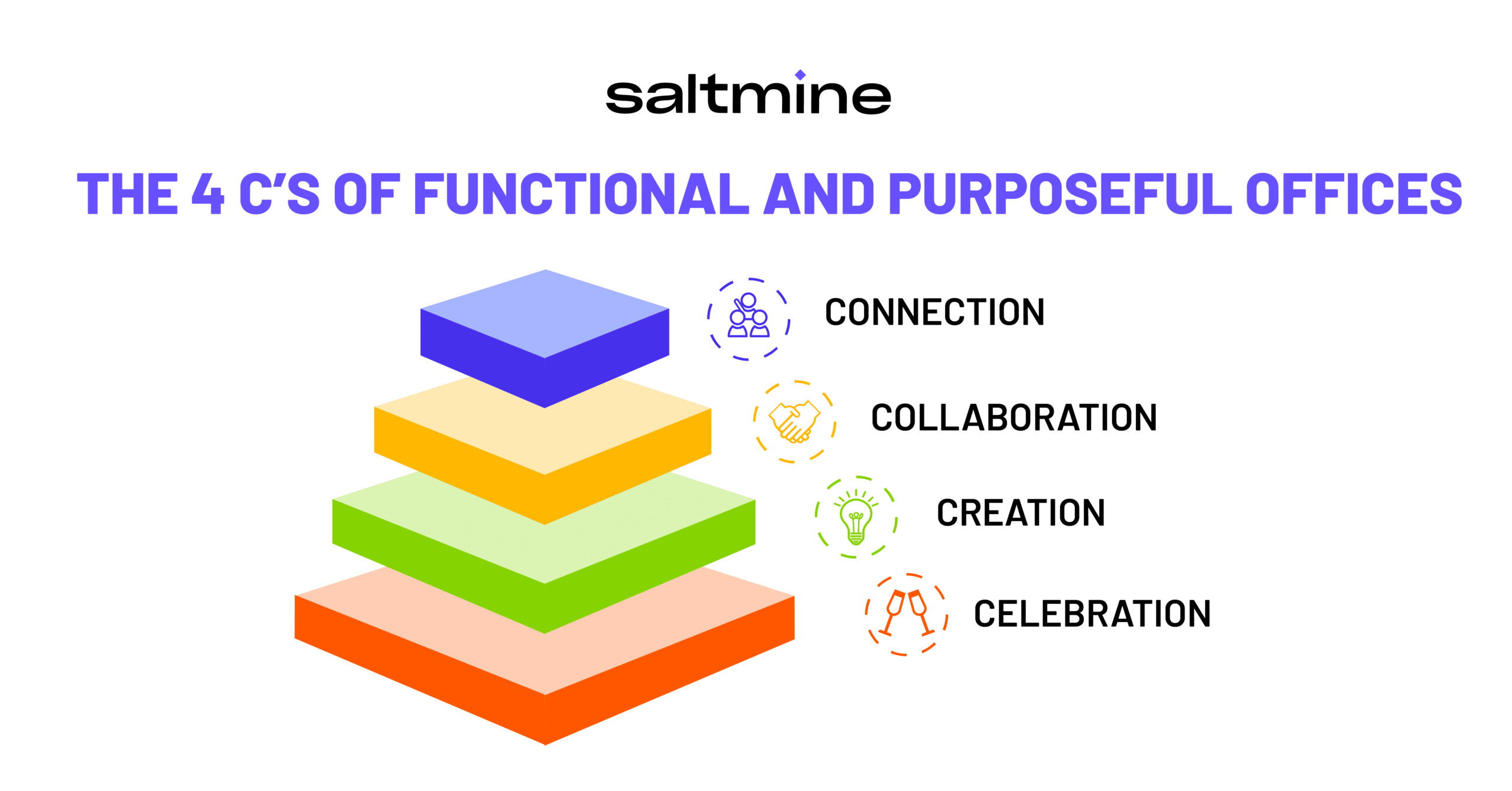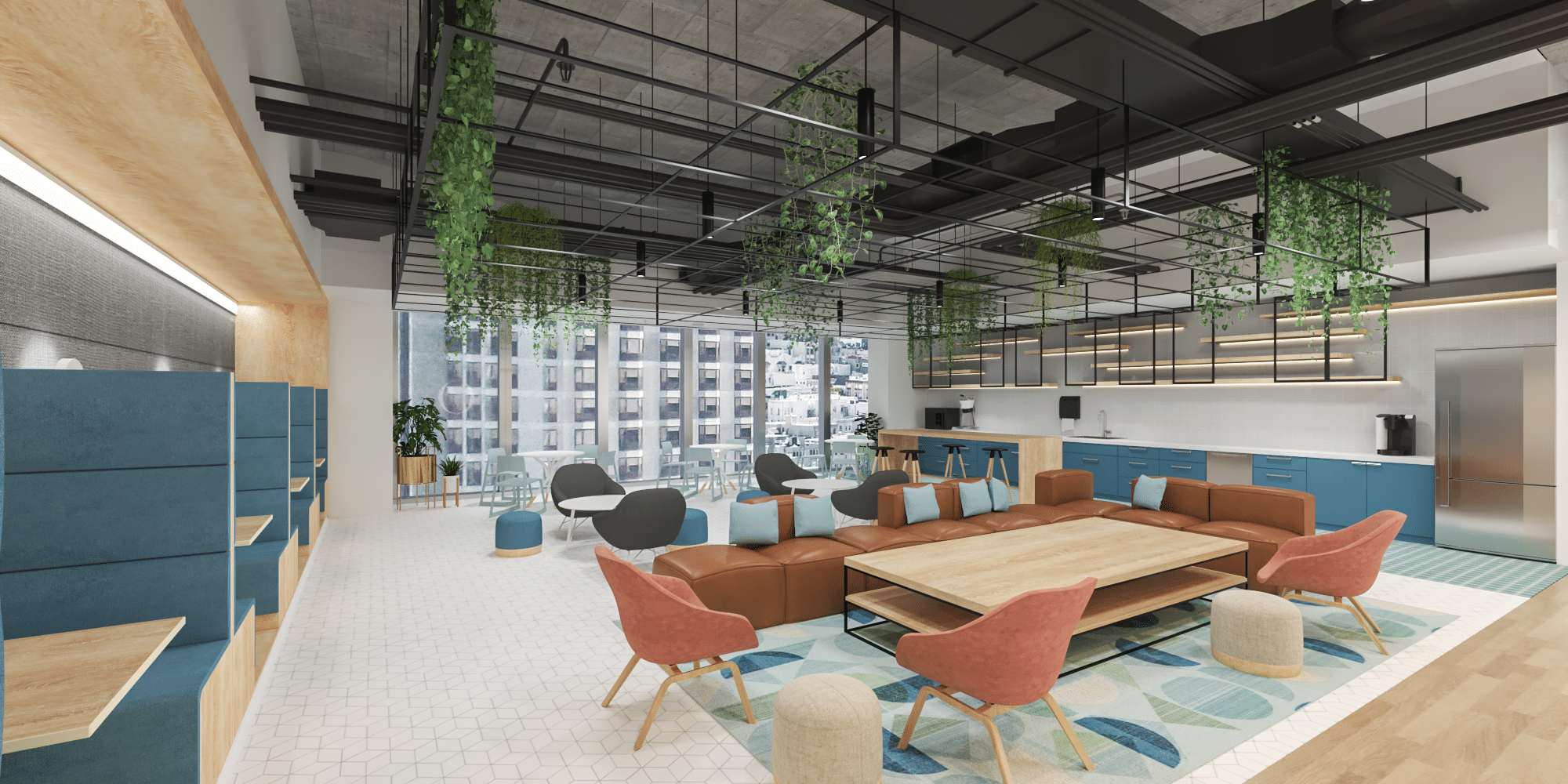It’s time to get serious about how to make offices not only functional but also purposeful and safe.
The following piece was reviewed by Saltmine’s Anvitha Boloor. Anvitha is a member of our Strategic Advisory Services team at Saltmine. With an architectural background and three and a half years of experience in the corporate real estate design and technology industry, she has a deep understanding of the landscape and keen understanding of what businesses are starting to identify as the future-of-work.
So, what is the purpose of office space, now?
From huddle rooms and communal spaces, to individual workspaces, the floorplans we left once the first lockdown went into effect, are of the past, right along with cubicles. And while many employees want to go back into an office–in varying degrees–looking at spaces to merely fit people into, is no longer conducive to people’s productivity, safety, and comfortability.
Workplaces–pre-Covid–were functional. For the most part, they got the job done and delivered a solid baseline for productivity and collaboration. However, they came with a lot of unnecessary rules and policies that have now been identified as irrelevant once we shifted to a work from home mentality. “Good work” is no longer defined as a task done at an office. In fact, throughout Covid and the shift to WFH, productivity rose, making the idea of “good work happens at the office,” an obsolete concept.
WFH: For some, the “devil is in the details”
With every rapid shift, there is always a converse reality. For example, while many companies and industries benefited from remote work, other industries didn’t adapt so intuitively.
This is particularly true of the gaming industry–which may come as a surprise since video games are now almost exclusively digital. Digital goods aren’t constrained by physical supply chains and in terms of revenue, the gaming industry did grow by 20% in 2020–a $180 billion increase.
Despite this monetary growth, the gaming industry did see a decline in efficiency. It’s reported that during the pandemic, delays in new releases and updates were delayed by almost 50%. The direct consequence of the rapid, remote-first shift is noted to be the biggest contributing factor to delayed releases among many leaders in the gaming industry. A project manager at Harmonix, states the remote-first shift “has made it much harder for the team to collaborate directly, which has always been a big part of how we make games. Traditionally, Harmonix has designed and built games using a very iterative process. We have social build reviews where the team reacts to prototypes, new features, new art, or whatever. The move to remote has made that aspect of our process difficult.”
The lack of having adaptive workplace strategies in place during Covid was a common mis-step; however, learning from examples such as these reveal a silver lining: Enabling “good” work in the still ever present Covid era is about connecting people to space, rather than fitting people into space. What it means to do good work is unique to the organization and their various teams’ workstyles–i.e., what works for a marketing team, won’t necessarily work for a team of developers and engineers.
Purposeful and safe workplaces
At the foundation of any physical office space, is its purpose–its why. A purposeful environment allows employees to feel out and understand what types of work get done, where.
For many teams, the true purpose of a physical space is to enable those little conversations and face-to-face interactions that drive creativity, collaboration, camaraderie, and innovation. Not necessarily because they can’t be accomplished remotely but because in many cases, they’re just done easier and more intuitively in-person.
With individuals and teams yearning for in-person collaboration, also come individuals who strongly value safety. For many, seeing one another again is exciting but as the pandemic has shown, our needs are evolving–specifically safety needs and policies that focus on the “whole human.”
Marrying an office’s function, purpose, and safety
 Put yourself in the shoes of a new hire and ask, “Do the environments in which they’re discovering clearly indicate what type of activities are done where–and are those spaces comfortable and inviting?”
Put yourself in the shoes of a new hire and ask, “Do the environments in which they’re discovering clearly indicate what type of activities are done where–and are those spaces comfortable and inviting?”
Working from home is so widely adored by many people because it’s comfortable–and comfortability is rooted in feeling safe. Covid has revealed itself to be an evolving thing which is concerning to many workers. In a recent survey, nine out of 10 people worry about how the virus could affect them and their families.
Conversely, the same survey also revealed that four out of 10 respondents believe the pandemic will lead to “reduced cross-functional collaboration” and 36% of respondents are weary about the continuing effects remote work may have on their work/life balance. Space innovators are leaning towards more residentially inspired, cultural “ports.” Physical manifestations of true function and purpose to allow colleagues to connect, collaborate, create, and celebrate. These are the things people miss and desire.
Example, even in pre-Covid times, Salesforce has always leaned into their “ohana” culture–designing warmer, more-homey offices.
To achieve this, spaces must be flexible and physical offices should be more multi-purpose. When people are truly free to make an office their own, and use them for what they need and desire, it instills a sense of pride in their shared, collective space. Much like when someone decorates and configures their own home–it makes it their’s.
When designing your workplace, think about what types of healthy activities you can facilitate that enhances the overall, in-office work experience:
Social, peer review-type activities
Going back to the gaming industry, what’s the best way to improve that technology? To iterate it and “play” with it–i.e., to show and tell.
Many gaming companies engage in “social build reviews” where teams can react, in-person to new prototypes, new features, new art, ideas, etc. Their office’s main function is showing, telling, collaborating, and brainstorming. When that space is eliminated, so is an entire team dynamic.
Team bonding activities
Whether it’s a new hire or a seasoned employee, having a space where teammates can see one another as human beings is critical for growing camaraderie and rapport.
With that being said, having just a “break room” still misses the mark. Spaces that have elements like soft surfaces, good light, approachable color palettes, natural furniture materials, and plants help people let their guard down, in a good way. It allows them to comfortably socialize, connect, and be open with teammates–all of which is key for team building.
Non-work related activities
Being able to actively repurpose space for social events is a must for fostering a happy company culture. Social lulls throughout the week allow for personal networking, cross-functional mingling, and most importantly, puts faces to names. It’s the macro-version of team building but serves as an exclusive time to pause and celebrate with colleagues.
“I find doing non-work things actually makes my time at the office more productive. Pulling out of my office routine gives my mind a break. That break allows new ideas and insights to bubble to the surface, enables me to see patterns I wasn’t seeing before, and casts work problems in a new light.”
Everything from catered meals and happy hours, to group yoga and sporting event watch parties–going to a place should be enjoyable and companies must have offices that can easily accommodate and host non-work related experiences that draw everyone together.
Culture and growth activities
Lastly, the growing need for culture building and goal-setting activities must be a top down initiative. From the C-suite to the entry-level contributor, offices should be the epicenters of company culture and growth.
Physically breaking down hierarchical silos and engaging in things like in-person Town Halls, All Hands, and Strategy Meetings doesn’t just bar set–it educates everyone of who they are as a collective. It’s crucial for your employee-facing brand to have a space for transparent “big picture” company activities.
For example, when a CEO comes out and says, “No one is going to have a dedicated, individual workspace at the office,” that CEO must lead the charge and give up their own office. Practicing what you’re preaching builds trust and inspires employees at every level. A CEO who uses phone booths and bookable private meeting rooms as necessary–like everyone else–can have a significant impact on how these practices are adopted, at-large.
The office: A valuable medium for human connection
Enhancing the most valuable medium for human connection is an exciting and nuanced undertaking–and what the space looks like is unique to the company, their various teams, and individuals. The ability to conceptualize and measure what an effective office looks like, now, is an evolving muscle.
To learn how to plan, design, and execute a workspace that truly captures the essence of your culture and celebrates your most valuable asset–i.e., your employees–watch the webinar below:
Enjoying our blog? Be sure to subscribe to stay up-to-date on Saltmine's original content with the form below!
 by
by 